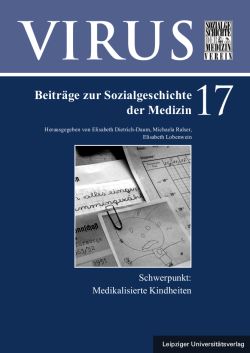
VIRUS Band 17, pp. 089-109, 2020/07/21
Schwerpunkt: Medikalisierte Kindheiten
Die neue Sorge um
das Kind vom ausgehenden 19. bis ins späte 20. Jahrhundert

In this essay, the drug is moved from different perspectives to the center of considerations. Drug studies on children in institutional care, different motivations and objectives as well as the interactions of different actors are being shown. The drug is the object of investigation, but also the source of effects on medically, institutionally and economically acting agents and thus the central actor. Children in institutional care were a readily available study population. So they could be tested on the antibody-inducing effect of vaccines. Studies with neuroleptics and sexual drive depressant drugs had no medically indicated target, but were rather “door openers” for the use of these preparations. With these drugs, a better traceability of the “inmates” should be achieved. This served to stabilize the “total institution” children’s home, and thus could be called a “social medication”.
Keywords: Medicalization, children, experiments on human beings, informed consent, Germany, clinical-trial